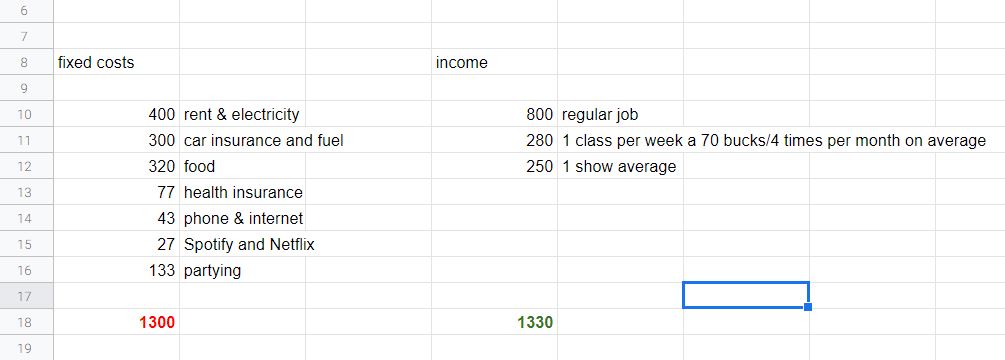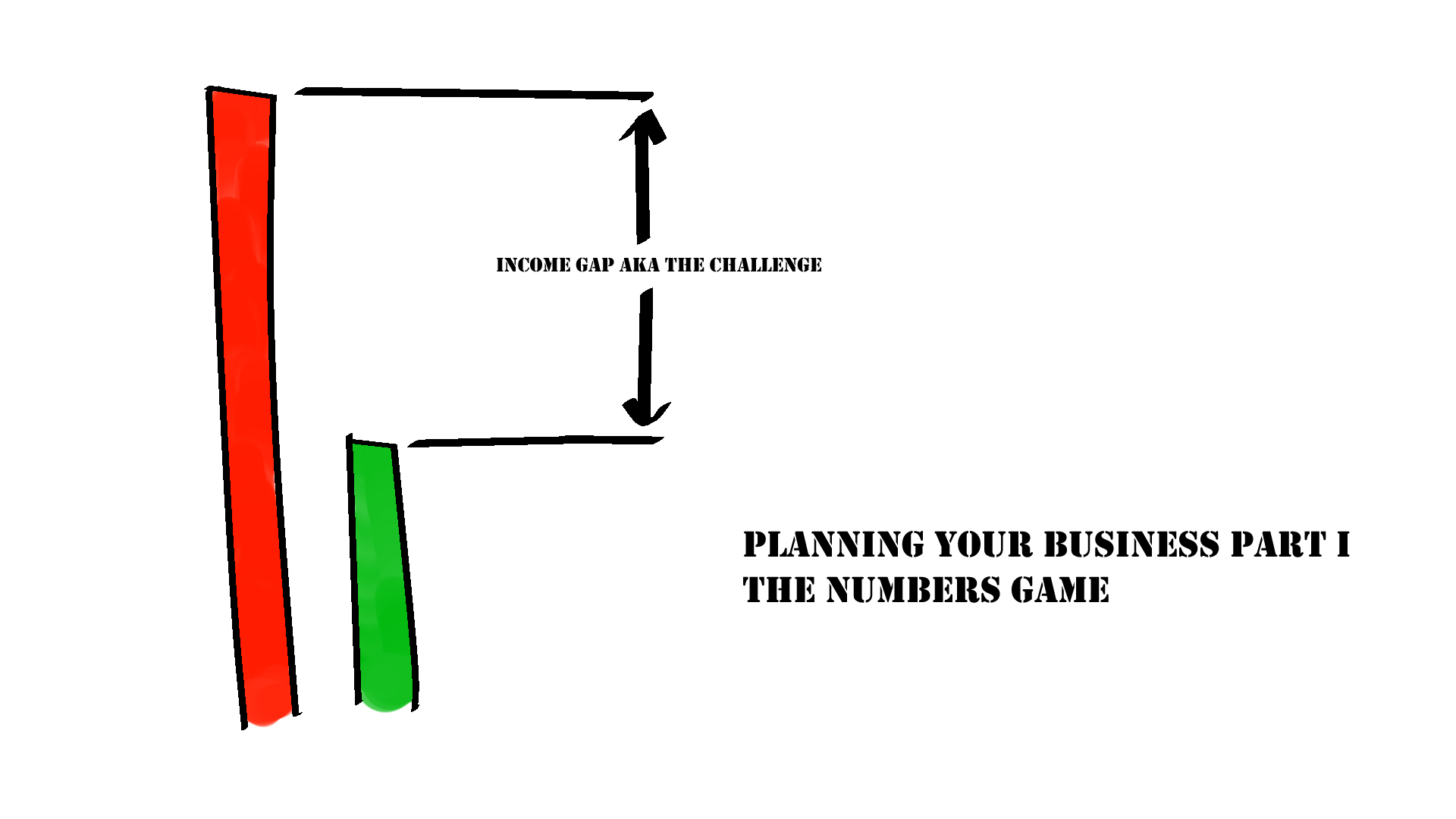The next step in being successful with our dance career is having a game plan. It is about knowing what to do to reach our goals money-wise and also from a satisfaction perspective. Today it is about the numbers. You need to evaluate your situation with brutal honesty and set a goal. From there we reverse engineer all the steps that are needed to make it happen. I will take you through this process step by step. This process is there to define your personal goals. They are ultimately what defines where you are going. Let’s call it the B-Boy/B-Girl or Hip Hop Dance Business Blueprint.
The following calculation uses numbers after tax. Meaning you calculate with the amount that stays with you after paying your taxes. How much you have to pay depends on the country you live in and the amount of money you earn. In most states, there is a certain threshold of earnings before you have to pay any taxes, and from there you have a progression of percentages you have to pay.
For the exact amount you have to put aside, you must inform yourself about your local tax laws as I can not cover that in detail. The best thing you can do is to talk to an accountant.
Many people think it is smart to start under the radar without invoices and illicit work. I don’t. If you have the fiscal authorities after you, your life is hell. So do this right.
Grab a notebook and a pen. If you want you can use something digital too, but I prefer the oldschool way for work like this because it keeps me away from distractions. Think about the following points and take down notes.
- How much money do you need to survive? Consider only your fixed cost per month and add 20% as a security buffer. If you are not certain about how to do that, check out this post about calculating your monthly expenses.
- How much do you want? Be honest. This number can be as high or low as you desire.
- How much do you earn at the moment from dance-related sources?
- How much do you earn at the moment from other sources?
- How much spare time do you have?
- How much savings do you have?
You see that all of those questions started with how much. The thing is: the planning we are doing is a numbers game, like every business. We are all here for the love of the dance but making a business work is knowing your numbers. Don’t forget that and don’t wing it.
You now know:
- Your short term (what we need to survive) and long term (what we want) goals of income.
- Your current situation. This gives us the difference we have to take care of aka the mileage we have to run before we win.
- Your resources (savings, current income, spare time).
- The things you can do from the last two posts about your possibilities and your dance business set up.
Calculating time again. You take the difference between your next goal (either fixed cost or desired income) and your current situation. Now you check what it would need to fill the gap with dance-related work. Sketch out multiple options, taking all the primary and secondary work fields that you found in the prior tasks into consideration. Draw one scenario for creating all the needed income with one primary work field only and one scenario for splitting it up over multiple work fields. Develop as many different but possible scenarios as you can. Write them down. Then walk away for a day or more.
Come back and check your developed options. Throw the ones that feel wrong away, burn them or get rid of them however you prefer. Take the remaining scenarios and think them through. Do you have one that works with your current resources? For example, you need to teach 2 more classes to reach your break-even point (where you earn what you need to survive). Do you have spare time for two classes? If the answer is yes: great. You found one way that is working without having to change a lot. Check all of your remaining options, just to check if there are more of the viable.
If there is only one option working, congratulations. Stop calculating, start executing.
If there are multiple options that might work, choose one. Roll a dice or flip a coin if you are indecisive. Making that decision is progress. Then start executing.
If you have no options that seem to work, you must free some time. This can be done by either stopping or reducing the time you spend in front of the TV, video games or social media or by reducing the hours you work in your regular job. If you work in a steady job that covers your fixed cost, you can take your time because you are not losing any money. Start by finding those additional hours that you can turn into dance related income. If you work 9 to 5 you can teach, practise, rehearse or choreograph in the evening and perform, compete or teach at the weekends.
As soon as you have a small income built, you gradually shift hours from your regular job to the dance. This transition can be as fast or slow as you are comfortable with. In order for this to happen with as little extra stress as possible, I recommend taking your time.
Example Calculation
Here you find an example on how to do the whole calculation. My tool of choice for doing anything math is either Google Sheets or Excel. In case you need a short introduction into this; let me know either in the comments or on social media. If enough people are asking, I will cover that in a post.

(the table calculation inside Google Docs)
short term goal: fixed cost of 1.300
long term goal: desired income of 3.500
income from a regular 20h job: 800
you don’t watch tv at night because you are busy practising with your crew
no savings
Primary work fields you consider valuable for yourself: performing & teaching, you love to battle but are not good enough to win major comps.
You and crew are doing regional small jams.
We need to close the gap from your income to your fixed cost first: this is 500 bucks.
You know that the shows you can do with your crew pay approx. 250 per gig. So you can dance two shows per month. Or you can find a studio that pays you about 70 per weekly class that you teach and do two of them.
You want to do all shows but are uncertain if you can land 2 gigs a month in the beginning. Therefore you decide to start 1 dance class and go for as many shows as possible with the crew. The one class takes away from your practise time but brings in some money.
For some month you are landing the shows as planned but then, you don’t book any shows for some month. You decide to go for another two classes because you don’t want to fall below you fixed cost again. With the 3 classes you earn about 200 (not all of them are full enough to pay 70) per week which adds up to 800. Together with 800 from your day job you have a stable 1.600 with fixed costs of 1.300. You did it.
Before we take this new situation as our starting point and work our way up to the desired goal, let’s take a break and check what happened.
In the example above we did not drop our day job. If we wanted to get rid of this one we would need to carry 500 more. If you keep that additional job it is highly recommended to swap it for a job that favours your dance stuff.
One of our decisions did not work: we wanted to cover our difference with teaching and performing. Performances did not work, so we shifted towards teaching. It could have gone the other way around.
Let’s keep going.
Our new difference is 1.900 as we need to work out way from 1.600 up to 3.500.
We still work 20 hours regular, teach 4,5 hours and have travel time to the studios of another 2 hours per week.
We still have plenty of time to practise.
For the sake of simplicity, we calculate classes with 200 a month and shows with 250 (you should make better deals if you can).
You can either teach 10 additional classes, do 8 shows a month or try a combination of both.
When you live in a big city it might be possible to teach 13 classes a week but in the bigger cities, there are often a lot of teachers too.
Booking two shows a week isn’t exactly easy either. Any combination might be hard because if you book shows outside town you will miss classes.
So what can you do?
If you favour teaching: Try teaching classes in the suburbs outside of town or cities nearby. If you have teaching days “abroad” with 3 or more classes this will add up fast. Just don’t forget to calculate with travel cost and your loss of time.
If you favour performing: Create a show with a few people and get an agency that takes care of your booking. If you have nobody to perform with, find an agency that sends you to auditions that might book you bigger jobs.
If you want to do both: Get a friend from your crew or somebody else who has the same or a better level as you to do your classes while you are performing. If you have to cancel your classes for performances, they will be gone soon.
Switch your day job when you have the possibility to get one of the secondaries that help your dance career. For example, start working at that artist agency when they hire.
You know the goal and you can take your steps. I could calculate the example to the end but there is no difference to the first half of the trip. There are no shortcuts, just taking one step after the other.
Start now, do your work … and you will make it.
If you need more help building your dance career, consider buying a copy of my book, The Dance Business Manual. In it, I outline the approach I used to transition to a full-time dance career.


4 replies on “Planning Your Business – The Numbers Game”
[…] I posted an article about how to plan your business when we only talk about the numbers. It was all about mapping out the road in front of you considering the financial side of […]
[…] the last weeks, we took an in-depth look at our own skillset and calculated the numbers that we need to survive while following our passion, either as a full-time job or side-hustle. […]
[…] do you need? Calculate your expenses, the time you have to earn your buck and check if it […]
[…] point: making a living as a dancer is not that much harder than finding regular employment that pays well and is good for your […]